Hope comes alive when we take action: 8 Good News stories 2025
Caroline Wagner, Francesca Cresta and Zinzi van der Aar
We are approaching the end of 2025 – once a distant marker used for environmental milestones and future promises of a cleaner, greener world to come. Now we are ten years after the Paris Agreement for climate action and fresh from concluding COP30 in Brazil. We’ve reached a moment that feels both urgent and full of possibility, but it still feels as if we are stuck. And certainly not making progress fast enough with the Global Goals for sustainable development, agreed by all 193 United Nations members back in 2015. So much can seem wrong in this world right now – geopolitical turmoil, unachieved climate targets, and future goals that seem unrealistic. The forces driving destruction are continuing to push the world toward crisis. From fossil fuel corporations, industrial agriculture and extractive industries, to big tech and political actors who attack accountability and sow division. Yet one thing remains certain: in troubling times, hope is an act of resistance. At Greenpeace, we know that collective action – across borders and generations – fuels hope. As part of a rising tide of people demanding dignity, justice, safety, social and ecological renewal, we are hopeful. Despite the setbacks and often overwhelming odds, so much good is still happening. Change is unfolding – sometimes quietly, sometimes boldly – driven by people and their communities, with courage and care for each other and the planet. Negativity is easy to see and feel, but positivity is powerful, and it’s what keeps us moving forward and keeps the momentum towards a brighter future for us all. As the calendar year comes to a close, it offers a moment to reflect back on the year we have just lived – and for some of us just survived – and perhaps we can even take a moment to be grateful for the progress people-power has made. That’s why we are here to share with you some of our most significant victories of the year – wins that prove progress is real, hope is justified, and action matters. The Global Ocean Treaty reached its 60th ratification in September 2025, clearing the way for this historic agreement to enter into force in January. With only 0.9% of the High Seas currently fully or highly protected, the Treaty is crucial to expanding protection, establishing sanctuaries that help mitigate the climate crisis, and safeguarding food security for the billions who depend on ocean resources. It is a landmark moment for protecting the ocean, and proof that countries can come together to protect our blue planet. The era of exploitation and destruction must end, and the Global Ocean Treaty is the tool to make that happen. This is a massive achievement – decades in the making – for all the activists, supporters and allies who raised their voices for ocean protection. Campaigners, coastal communities, small-scale fishers, scientists, and ocean lovers everywhere can hold on to this moment as proof that when millions of us demand change, we can achieve what once seemed like a distant dream. But the fight for the protection of our Ocean is far from over. Scientists are clear that we need to protect at least 30% of our ocean by 2030. Governments around the world must use this time to ensure the first historic ‘Ocean COP’, set for 2026 becomes a turning point, and start to develop plans for the first-ever sanctuaries under the new Treaty. Our ocean can’t wait, and neither can we. In June the Indonesian government announced it would revoke four out of five active nickel mining licences in Raja Ampat, West Papua, following growing scrutiny of mining activity in the archipelago. Tens of thousands of people signed and posted under the banner of #SaveRajaAmpat in just a matter of days. The decision came the same day Greenpeace Indonesia released its Paradise Lost? investigation, which documented the scale of the threat nickel mining poses to Raja Ampat – often referred to as “The Last Paradise on Earth”. The report identified 16 nickel mining licences. Twelve of the licences are located within the UNESCO-listed Raja Ampat Global Geopark, and four active licences were on small islands where mining should be prohibited under Indonesian law. While the government’s announcement represents a significant development, it does not yet secure full protection for Raja Ampat. The permit for the largest mine remains in place, and past experience shows revoked licences can be reinstated. Together with local and Indigenous Peoples in West Papua, Greenpeace Indonesia is calling for the permanent cancellation of all mining permits, the prevention of nickel and smelter development linked to Raja Ampat, and robust legal safeguards to ensure mining cannot return. This decision demonstrates the impact of sustained investigation, Indigenous Peoples’ resistance and public pressure. It marks an important step toward lasting protection for one of the world’s most biodiverse regions. After 6 years of campaigning led by 27 law students in the Pacific Islands, the International Court of Justice (ICJ) issued a landmark Advisory Opinion that strengthens states’ obligations in the climate emergency beyond the Paris Agreement in July. It confirms that all countries have duties to prevent significant environmental harm and that states must regulate businesses for the damage caused by their emissions, no matter where that harm occurs. The court also affirmed that the right to a clean, healthy and sustainable environment is fundamental to all other human rights. This Advisory Opinion signals a new era of global climate justice. By clearly defining states’ international climate duties and the consequences for breaching them, the ICJ opens the door to new cases that could bring justice to communities suffering the worst impacts of a crisis they did little to cause. The court’s message is unequivocal: fossil fuel production, consumption, and the granting of licenses and subsidies may violate international law, and major polluters must stop emitting and pay for the damage they have inflicted. In October, a Paris court issued a significant ruling against TotalEnergies’ misleading advertising. The case, brought by Friends of the Earth France, Greenpeace France, and Notre Affaire à Tous with support from ClientEarth, challenged the company’s attempts to present itself as a climate-responsible actor while continuing to expand its fossil fuel activities. TotalEnergies claimed in its ads that it placed “climate at the heart of its strategy” and aimed to deliver “cleaner, safer and more affordable energy,” highlighting its 2050 net-zero ambition. The Court found these claims likely to mislead consumers, noting that the company is simultaneously increasing its production and investment in oil and gas – a trajectory incompatible with scientific recommendations and the Paris Agreement, which call for an immediate reduction in fossil fuel production. This judgment is the first to recognise the oil industry’s net-zero messaging as greenwashing. It marks an important step towards holding major polluters accountable for misleading the public and delaying real climate action. In November, a Kenyan court delivered a groundbreaking judgment declaring that seed sharing among farmers is legal, marking a significant victory for smallholder farmers and allies defending food sovereignty in Africa. For years, Kenyan farmers have lived under the shadow of a law that threatened jail terms of up to 2 years and a fine of 1 million KES (about 7,800 USD) for selling or exchanging unregistered seeds, effectively handing control of the country’s food system to multinational corporations. This landmark decision protects traditional farming practices and the rights of small-scale farmers to save, exchange, and plant seeds freely, challenging corporate control over agricultural resources. The verdict reinforces community-based seed systems that have sustained food security for generations, setting a powerful precedent for defending farmers’ rights and biodiversity against restrictive seed laws that favour large agrochemical corporations. After months of public pressure, the Banco do Brasil updated its environmental and social rules for rural credit. The bank will now block loans to any rural property with environmental embargoes, require proof that any deforestation was legal, and check state embargo lists even if they are not on the federal system. These changes answer key demands from Greenpeace Brasil, which showed how weak rules were allowing public money to fund deforestation, fires and other environmental damage. The update is an important step, but more needs to be done. The bank still doesn’t fully prevent credit for farms that use illegal fires, and it has not required clear traceability in cattle financing – one of the main drivers of deforestation. Even so, the pressure from society, investigations and public actions has already brought real results and sent a strong message: public money cannot continue to support activities that destroy forests. Take action now to protect the Amazon and all the world’s forests. The European Free Trade Association (EFTA) Court confirmed in May that Norway must count all climate impacts when approving new oil and gas projects – not only the emissions from drilling, but also the much larger emissions released when the oil and gas are burned anywhere in the world. This supported the case brought by Greenpeace Nordic and Natur og Ungdom (Young Friends of the Earth Norway), and showed that the Norwegian government was wrong to ignore these “Scope III” emissions, which make up about 95% of a project’s climate damage. The decision has major consequences for all future fossil fuel approvals in Norway and across Europe. Courts are recognising that protecting people from climate harm is a legal duty, not an option. The ruling follows similar decisions in the United Kingdom, the United States and Guyana, and strengthened an earlier win in the Oslo District Court, where approval of three North Sea oil and gas projects was found invalid for failing to assess these emissions. The Norwegian government appealed the earlier win, but in November the Borgarting Court of Appeal once again ruled in our favour, reaffirming what the Oslo District Court, the EFTA Court and the European Court of Human Rights, had already made clear – governments must assess the full climate impacts of oil and gas projects, including emissions caused by burning the fuels abroad. This is a huge victory for everyone who is fighting for a safer future, it proves that our struggle for climate justice has real force. In November, the United Kingdom (UK) government slammed the door on new oil and gas exploration in the North Sea. This makes Britain the largest economy to end new fossil fuel exploration. After nearly three decades of campaigning – from activists clinging to rigs in Arctic storms to lawyers dismantling government decisions piece by piece – this is a historic moment for the climate movement and a win that once seemed impossible. Greenpeace UK first campaigned on the issue of oil exploration licensing in 1997! This doesn’t mean all oil and gas production will end immediately. The end of exploration licenses means companies can no longer get permission to search for new oil and gas reserves in previously untapped areas. But it’s still a major change. Every new field discovered locks the UK into decades more drilling, more burning, more damage. This decision cuts that cycle off at the source. So existing UK North Sea fields will produce until they run out, or until production stops for some other reason. But without new discoveries, production will steadily decline until it reaches zero. The North Sea fossil fuel era has a finish line now, and that’s exactly what the climate needs. More countries must follow to ensure a just transition to clean energy, and fast. These are only some of the victories that we want to remember, cherish and bring with us as the year comes to a close. But there are many more that we have not mentioned here, just as important, that show us that the environmental movement, united, can in fact bring about true change. It’s not easy, sometimes it is not apparent, but we are doing it every day. So as this year comes to an end, we hope that we can fuel you with hope and happiness, rather than doom and gloom. We’ll continue our actions next year and we certainly hope that you will join us. Together we can make a change. And if ever you feel overwhelmed by the enormity of the world that we live in today, know that you have a choice. You have a choice to either feed the negativity that weighs you down, or you can choose to celebrate the good and surround yourself with tangible actions and progress, no matter how small. A quiet moment of reflection, a deep breath and meditation may support you too if you are struggling with climate anxiety. Start a conversation about why/how we need to resist alongside people in your community. Caroline Wagner is Programme Support Manager for the European Collaboration at Greenpeace Germany. Francesca Cresta is Executive and Governance Assistant at Greenpeace Italy. Zinzi van der Aar is a Writer/Editor at Greenpeace Netherlands. Texte intégral (4939 mots)
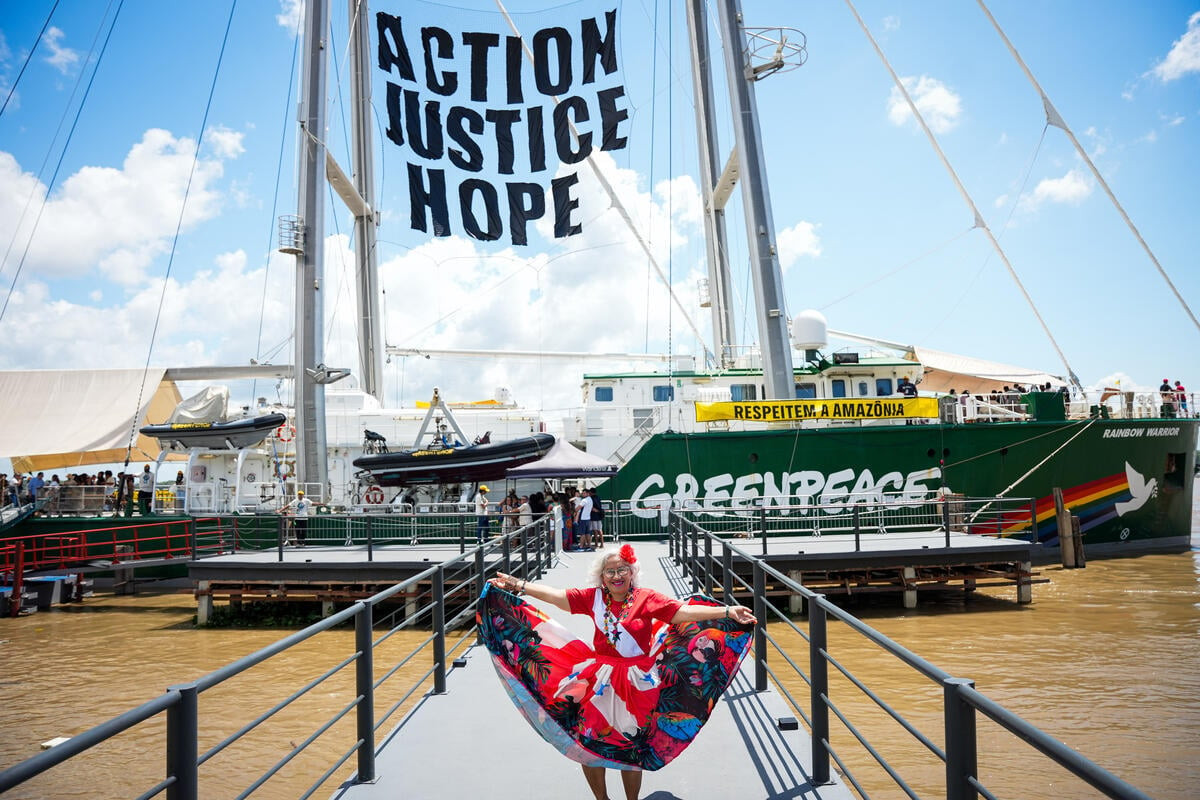
1. Global Ocean Treaty set to come into force
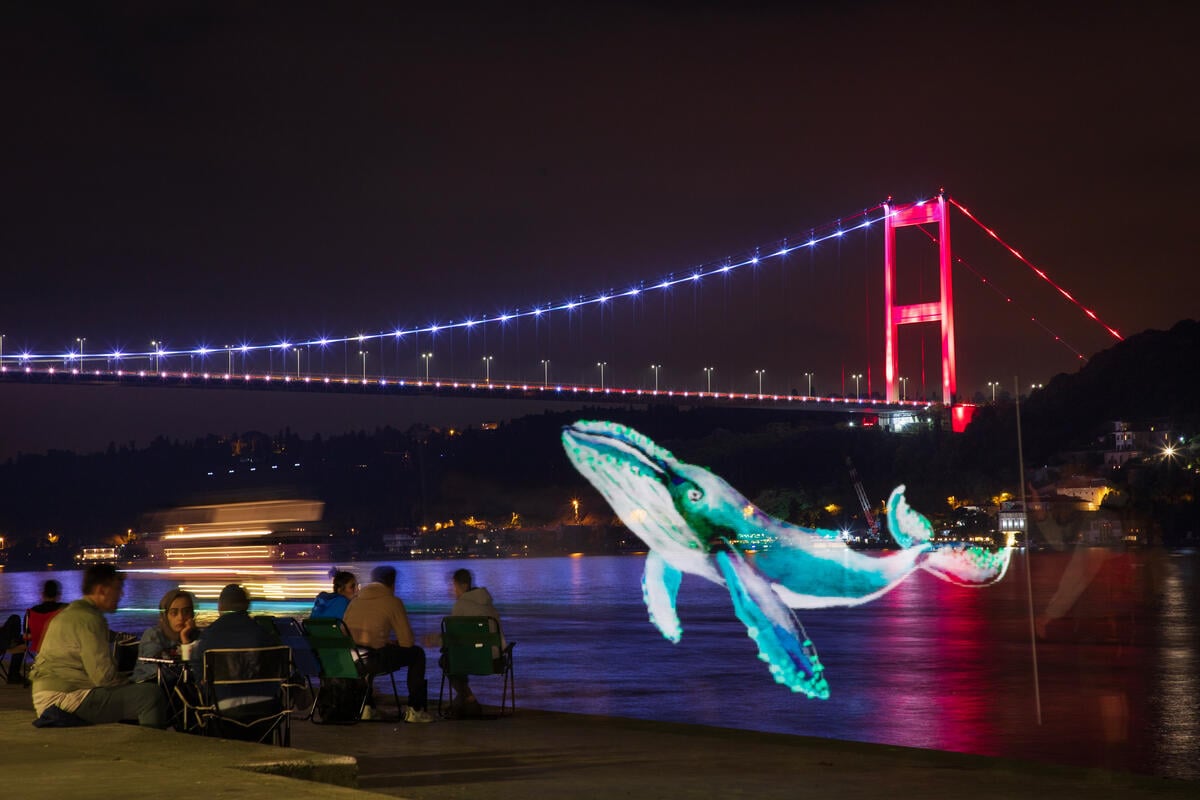
2. Raja Ampat: Victory for ‘The Last Paradise on Earth’
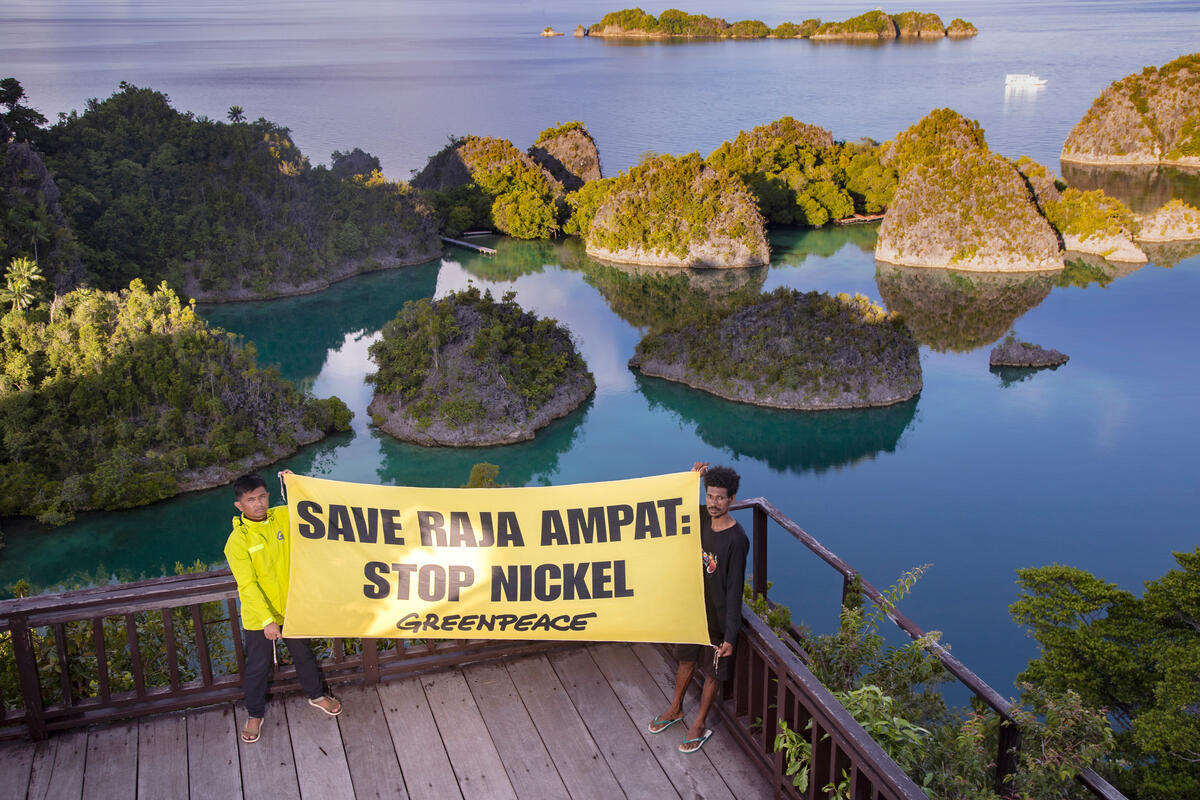
3. World’s highest court delivers historic protections for climate-impacted communities
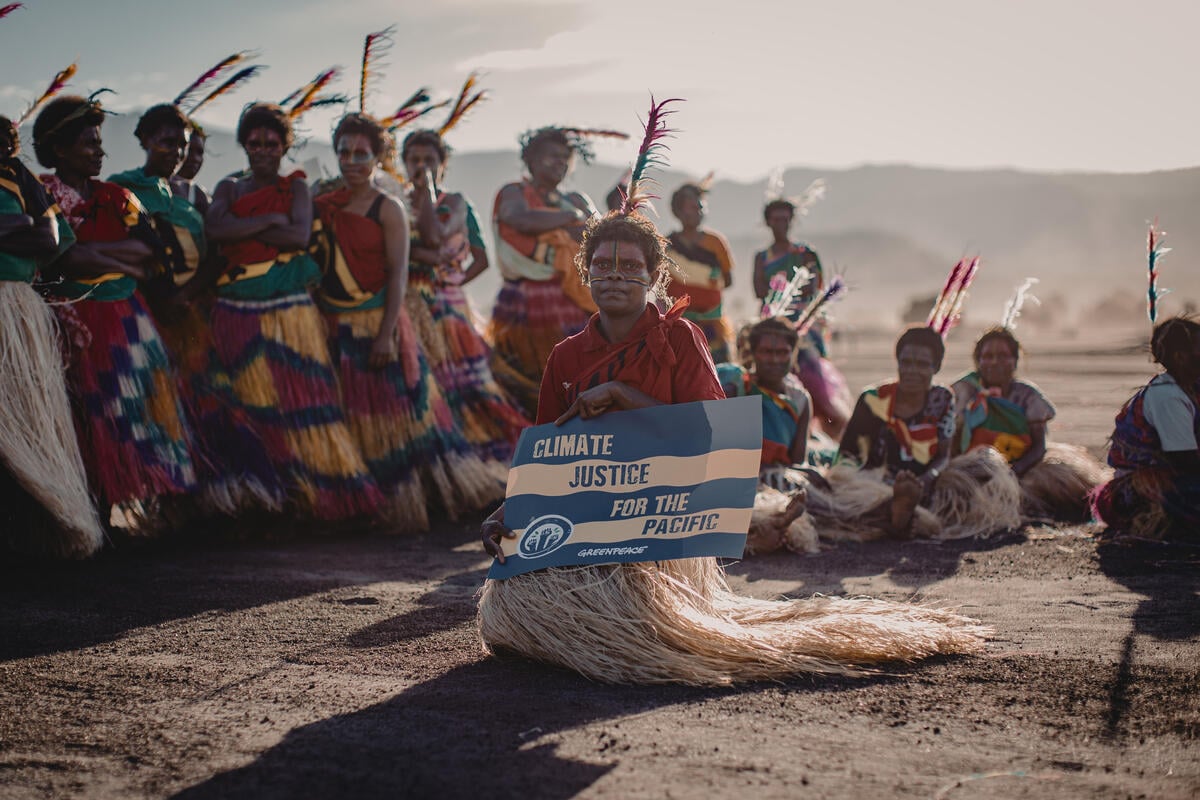
4. Landmark trial on greenwashing holds oil and gas corporation to account
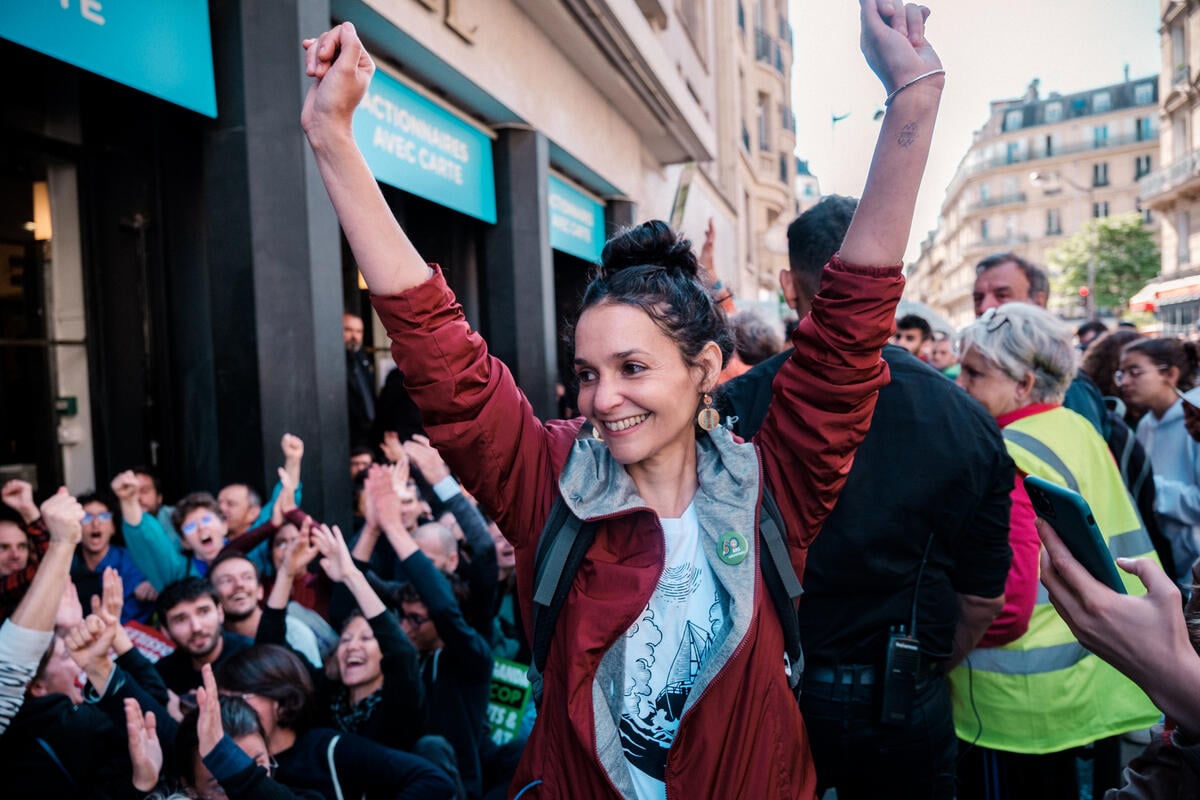
5. A huge step towards seed sovereignty in Kenya
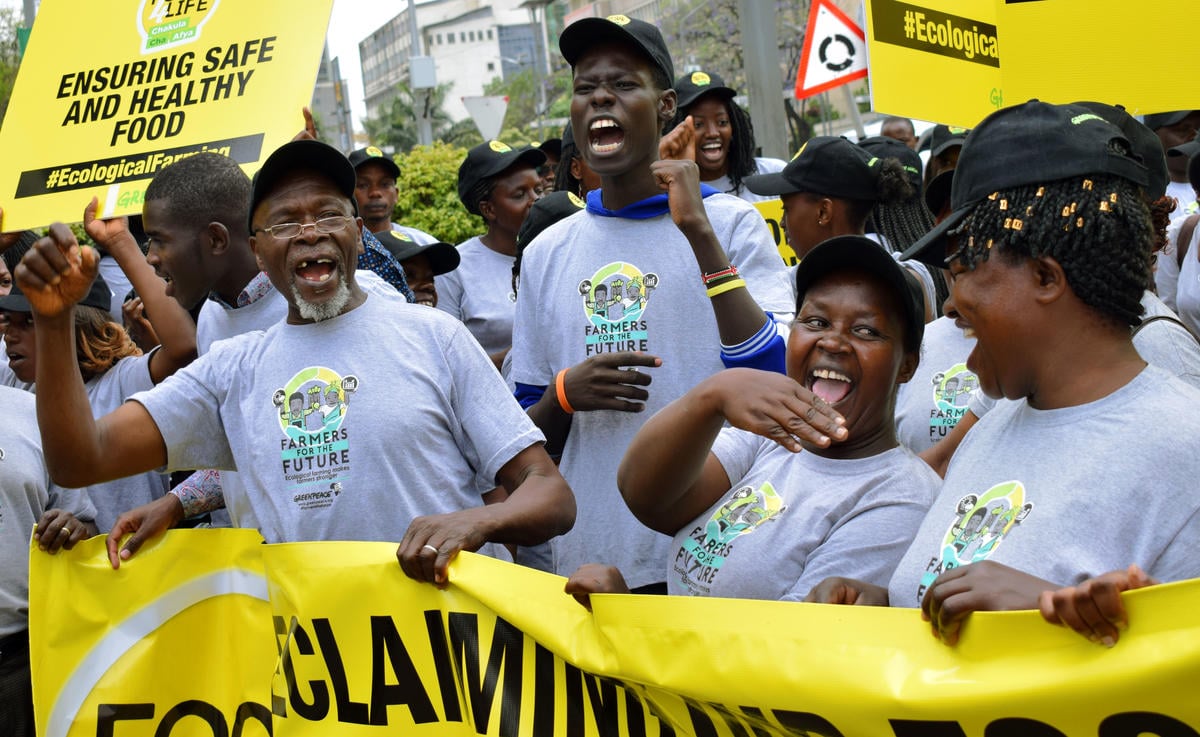
6. Banco do Brasil moves: An end to public financing of Amazon destruction
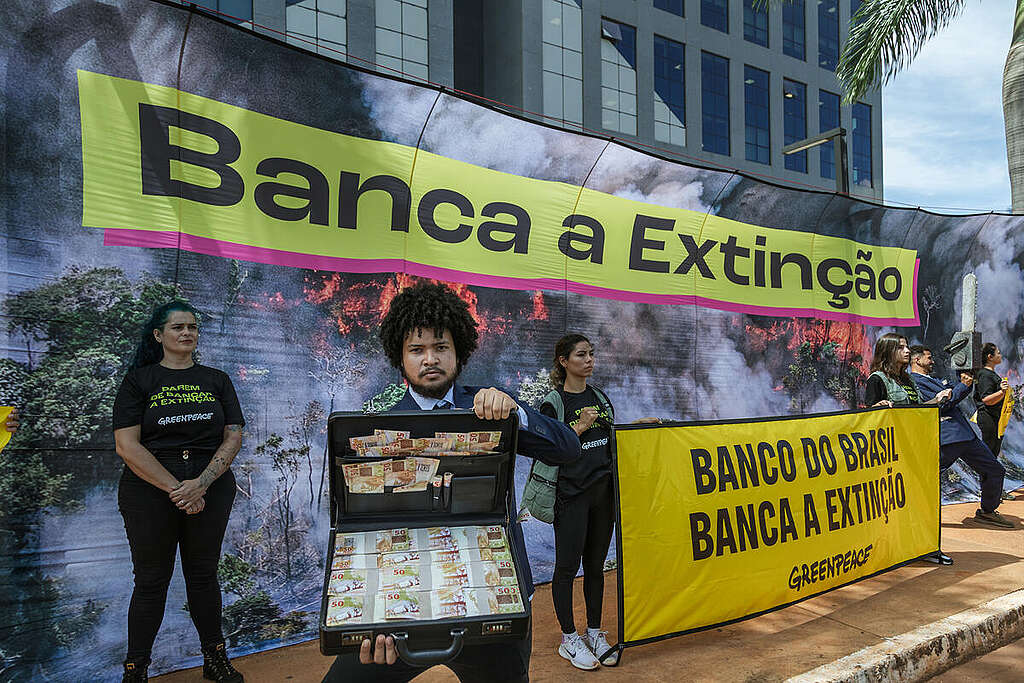
7. Youth and environmentalists hold Norway to account on oil exploration
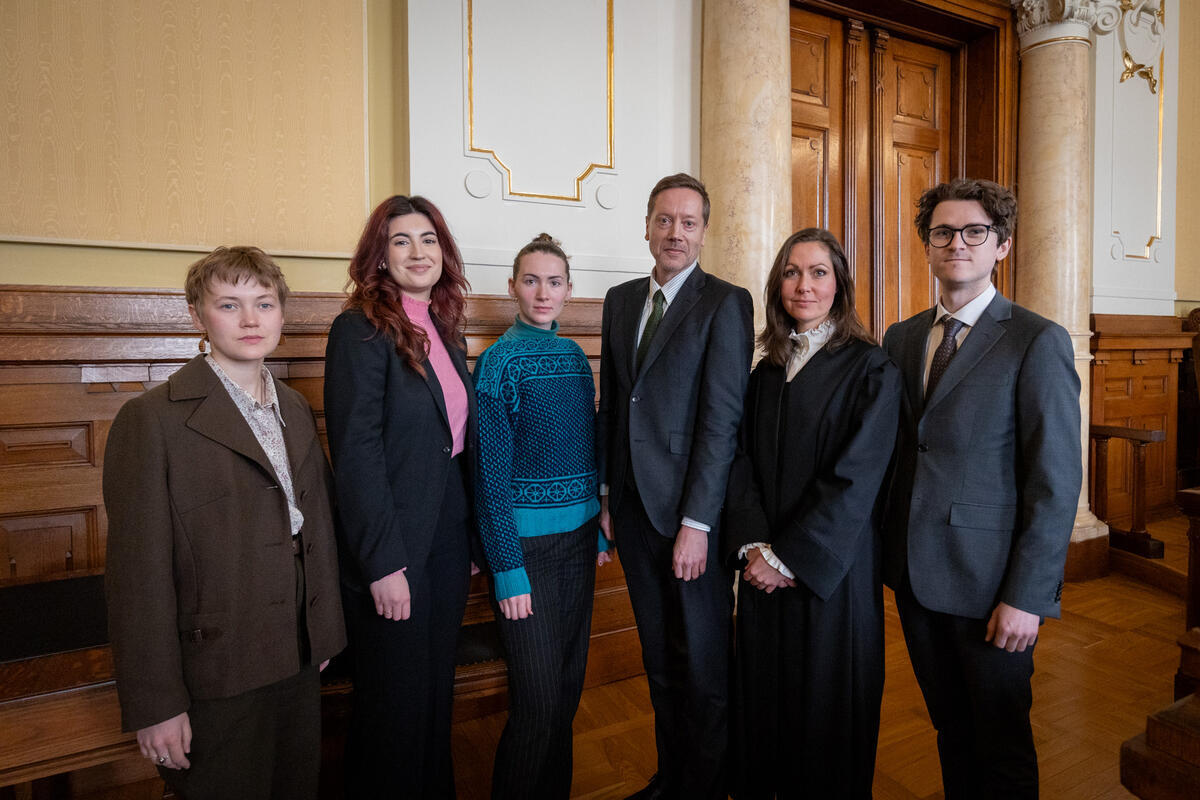
8. The end of new oil and gas exploration in the UK
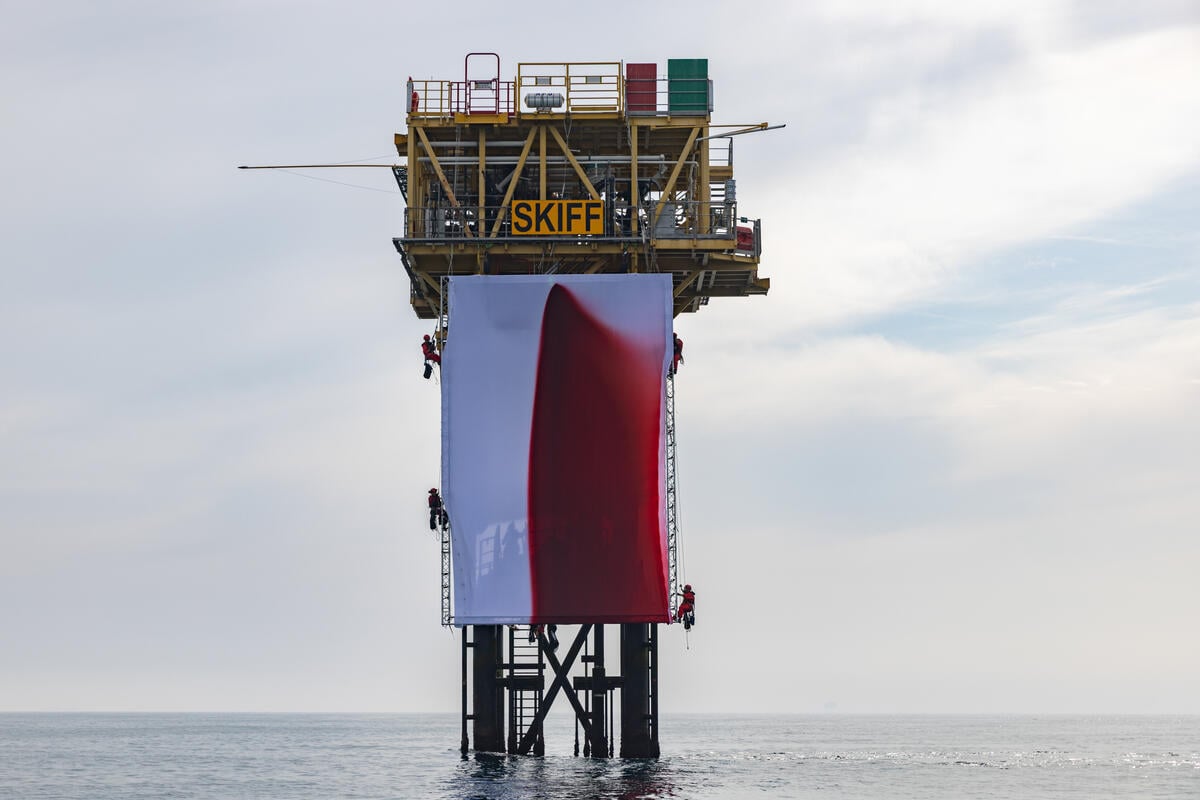
But wait, there’s more…
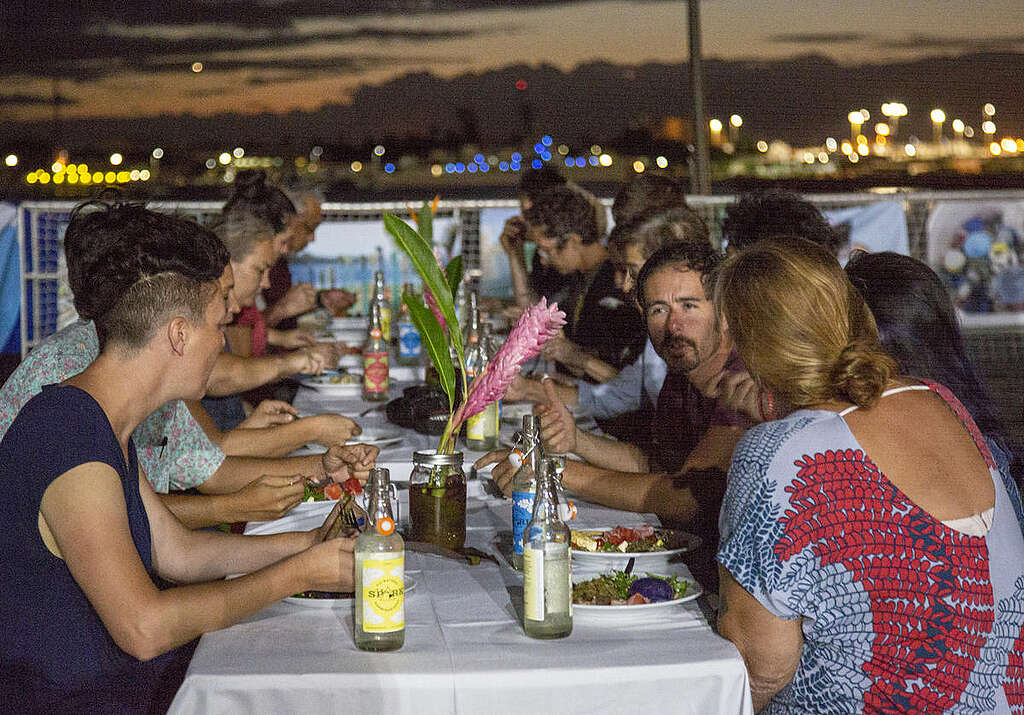
Russia’s fossil fuel war economy drives oppression and climate breakdown
Greenpeace International
A new report – the most far-reaching analysis of environment and environmentalism in Russia since 2022 – shows how Putin’s regime relies on a toxic troika of extractivism, authoritarianism and war. Fossil fuels finance war. War justifies repression. Authoritarianism shields elites from scrutiny while blocking demands for justice. Its veil of disinformation, propaganda and control of information is now so thick that free reporting on Russia now depends on information gathered from outside its borders: the world’s largest country has become a void of reliable information. This cycle devastates nature, dismantles institutions, oppresses societies, and poses a systemic threat to global security and environmental stability. Russia’s unprovoked aggression against Ukraine is also a danger to the wider world – but, frighteningly, it can provoke other cases. Its hostility is a warning to the world of how far an authoritarian regime based on fossil fuel economy can go. Russia’s invasion of Ukraine sent shockwaves around the world. It has brought death, devastation and displacement to millions, triggered one of the largest refugee crises of the 21st century, and upended energy, trade, finance and food systems worldwide. Over three years since Russia’s full-scale assault in February 2022 – which itself came after eight years of illegal occupation of Crimea and parts of Donetsk and Luhansk – the consequences of Russia’s invasion continue to reverberate. Russia’s occupation and weaponisation of Ukraine’s nuclear power plants, including Europe’s largest, not only presents a chilling reminder of the Soviet era Chornobyl disaster that sent a cloud of radiation – and existential terror – as far away as North Africa and Canada. It also creates an unprecedented, more direct and more sinister threat to Europe and the wider world. Natural systems in such a large country as Russia have an enormous influence on global environmental and climate stability. Nearly half of Russia is forest, which, alongside vast tundra, wetlands and permafrost, stores immense carbon reserves and safeguards biodiversity (see chapter 4: Biodiversity Crisis). Forest loss could accelerate the climate crisis and trigger irreversible ecological damage but under Kremlin policy, these ecosystems risk losing resilience fast: over half of Russia’s forest is deemed exploitable; fires spread unchecked; permafrost thaws, and fragile habitats fragment. Meanwhile, the risks of environmental and technological disasters continue to grow. Corruption, ageing infrastructure and dismantled oversight systems make spills, leaks and industrial accidents more likely (see chapter 1: Socioeconomic Context). One doesn’t have to look far for an example: in December 2024, a disaster in the Black Sea, affecting the Russian coast as well as the coast of temporarily occupied Crimea, made headlines worldwide, when reportedly several thousand tons of heavy fuel oil spilled into the water after two tankers wrecked in a storm in the Kerch Strait. Thousands of volunteers rushed to clean the coastline and protect wildlife, while the authorities once again failed to deliver an adequate response to a disaster rooted in their fossil-fuel-dependent system. The Russian Arctic is now a militarised and ecologically vulnerable zone. Warming four times faster than the global average, it is under pressure from oil and gas drilling, military expansion, and the breakdown of international cooperation. Indigenous Peoples are being displaced from their land, their rights ignored and livelihoods destroyed. Beyond its borders, Russia exports its extractivist model. Through fossil fuel projects in Uganda, Egypt, Mozambique and beyond – and nuclear deals pushed by state nuclear corporation Rosatom, which is implicated in war crimes allegations at Ukraine’s Zaporizhzhia nuclear power plant – Russia locks countries into dependency while enriching elites. International actors remain complicit: many states and corporations continue buying Russian oil, gas and raw materials, sustaining war, repression and destruction. Greenpeace activists worldwide, however, continue to speak out boldly, urging their governments to sanction Russia’s shadow fleet and halt purchases of Russian fossil fuels. At global forums like G20 and BRICS+, Russia systematically obstructs and sabotages international cooperation, hiding behind “resource sovereignty” to weaken binding climate and biodiversity agreements. Many of its “green” organisations are state-controlled, while genuine environmental governance has collapsed into imitation initiatives and propaganda. The lesson for the world is stark: when countries promote reckless extractivism or elites profiteering from destruction, or let fossil fuels dominate their economies, they risk sliding into the same dangerous cycle. The erosion of democracy, the fog of propaganda, and the silencing of dissent go hand in hand with environmental collapse and vicious war-mongering. The Kremlin has cracked down on civil society, dismantling independent organisations and shrinking access to environmental information. Public oversight is almost impossible – but groundbreaking analysis like this proves reporting can cut through the silence. Moreover, it shows that environmental issues remain one of the few areas where ordinary Russians still find solidarity, even under severe constraints. Many organizations were forced to be closed, and many activists had to leave the home country. Those who remain tend to avoid confrontational topics, use coded language, and focus on expert reports, online petitions, or participation in state advisory councils. Local ecological protests, such as against landfills or industrial projects, continue and sometimes yield local victories, but systemic change is rare amidst the state intimidation. Greenpeace Russia was forcibly closed after 30 years of defending forests, rivers and communities. But repression has not silenced the movement. Twelve years ago, the Arctic 30 were arrested at gunpoint for peacefully protesting Arctic oil drilling. Their detention sparked a global outcry, and they were freed after three months. Russia was ordered to pay damages. The episode reminded the world of the power of solidarity, as people across the globe stood together to defend international activists risking their freedom to speak out for the planet. Today, grassroots resistance in Russia still connects with international allies, keeping alive the hope of a sustainable alternative. Russia holds enormous potential for a different path: vast renewable resources, rich biodiversity, scientific expertise and strong public concern for the environment. But unlocking that potential requires fundamental change: an end to aggressions, restoration of civil society, a shift away from extractivism towards sustainability and others. Even as Putin’s assault on civic space in Russia continues, the environment remains one of the few subjects where civic engagement persists — offering potential that, if nurtured, could contribute to broader shifts in Russian society. Russia is a warning for other countries whose government agenda depends on fossil fuel extraction, authoritarian rule and militarism. It is also a powerful reminder: without resistance there is no fair, green and peaceful future. But repression breeds resistance – and Greenpeace continues to bear witness and break the silence. Governments and powerful elites have tried to silence us before, by bombing our ship, suing Greenpeace entities, shutting down offices and attempting to erase our existence. It didn’t work then, and it won’t work now. Our movement is global. It is unstoppable.Solidarity fuels hope. Together, we can resist, rebuild and create a fairer, greener and more peaceful future. Tell Energy Transfer and other corporate bullies: Stop your attacks on free speech. Texte intégral (2663 mots)
A toxic troika of extractivism, authoritarianism and war
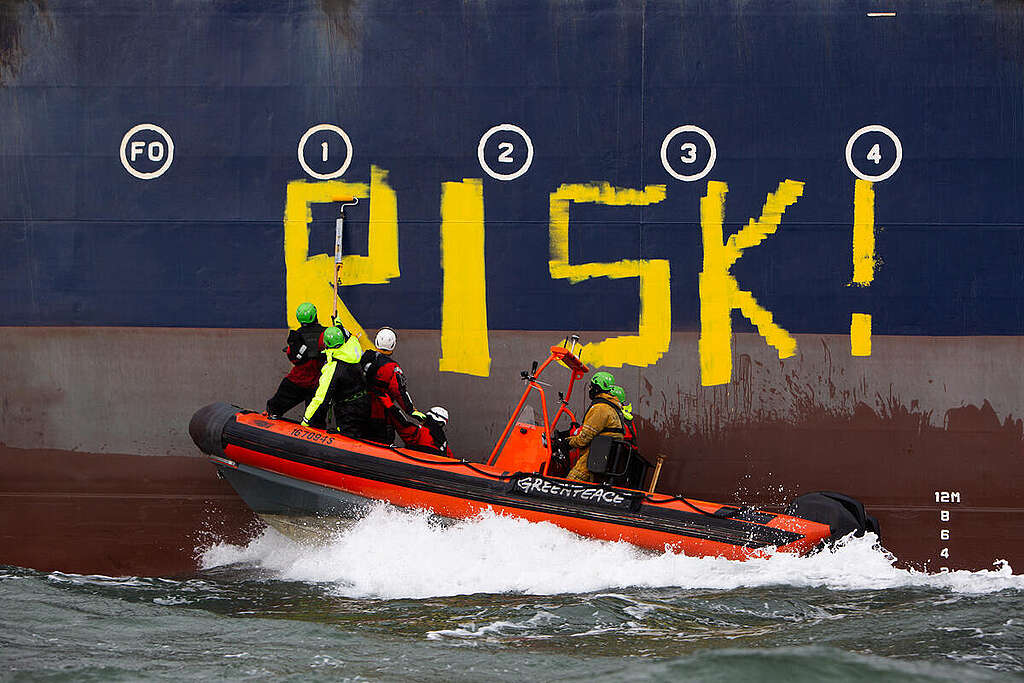
Russia’s aggression against Ukraine
From the Arctic to Africa: a global threat with global consequences
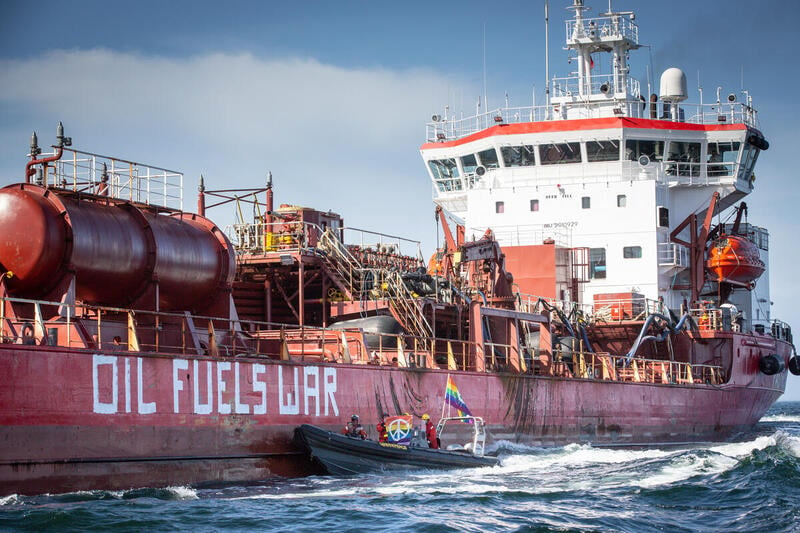
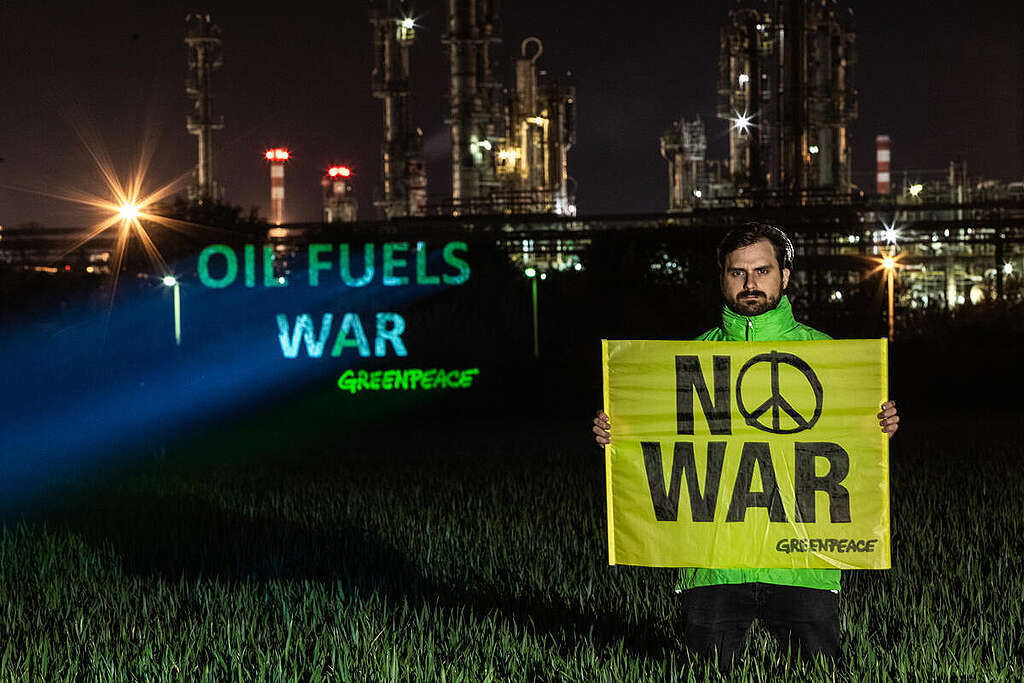
A warning to the world
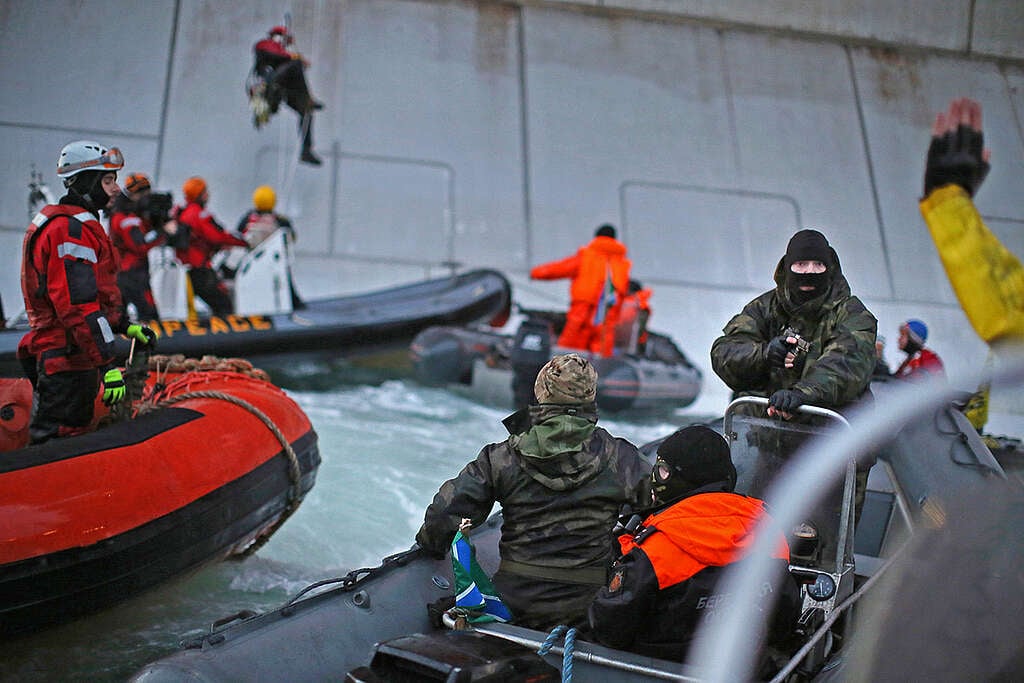
…as the hope for resistance endures, solidarity continues to grow
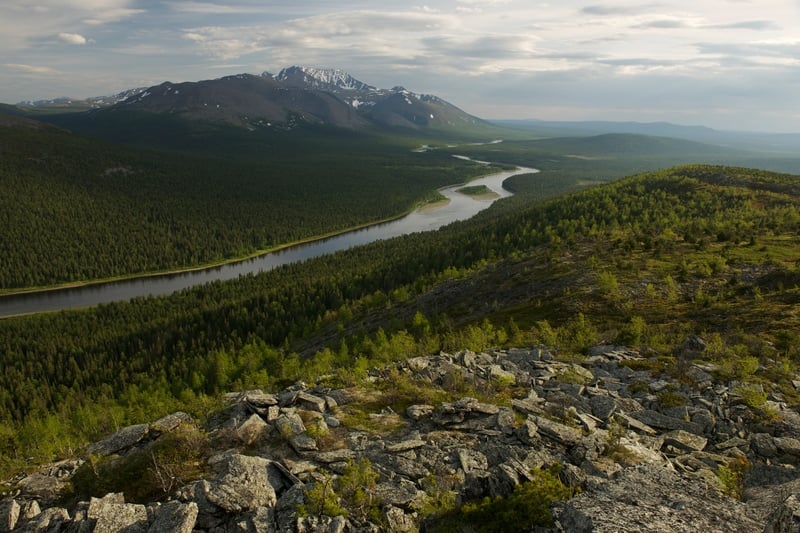
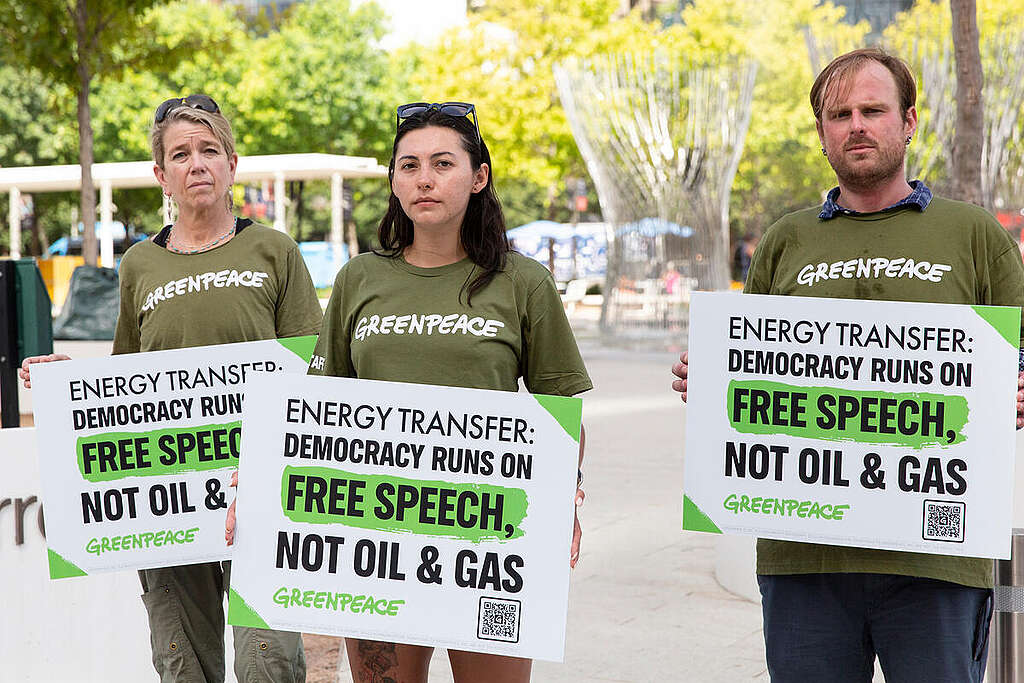
2025 in Images
Sudhanshu Malhotra
2025 has been yet another year marked by some serious climate emergencies. Throughout the year, we saw irregular weather patterns, back-to-back typhoons, torrential rains, flash floods, forest fires, and polar vortexes — all of which are exacerbated by the fossil fuel-caused climate crisis. These climate disasters have resulted to thousands of people dying, and millions being forced to leave their homes. This is the reality for so many people all around the world, many of whom have contributed the least amount of climate damage. But the stark contrast to these disasters are the images of courage and hope that we saw year-round: everyday folks rising up against all odds to take charge of their destiny, demanding a better future for all. People from different parts of the world, including Thailand, Sri Lanka, Mexico, Cameroon, Romania, Brazil, the Philippines, and Kenya, have chosen to seek solutions and demand reparations from polluters who have long taken advantage of natural resources, people’s livelihoods, and our collective future. The resilience, bravery, and hope of these people have been the most inspiring, and will fuel the future where we will no longer be taken for granted by the billionaires who only seek to achieve personal gain. Overwhelmed by the sheer volume of images this year, below is a small selection of the most inspiring images of 2025. Texte intégral (8418 mots)
These images fill us with the promise that 2026 will be a continuation of people power; of standing up for our rights and for the next generations. They are a reminder that we need to hold governments and polluting corporations accountable — and that we need the systems to shift towards an equitable and just world where everyone is winning. 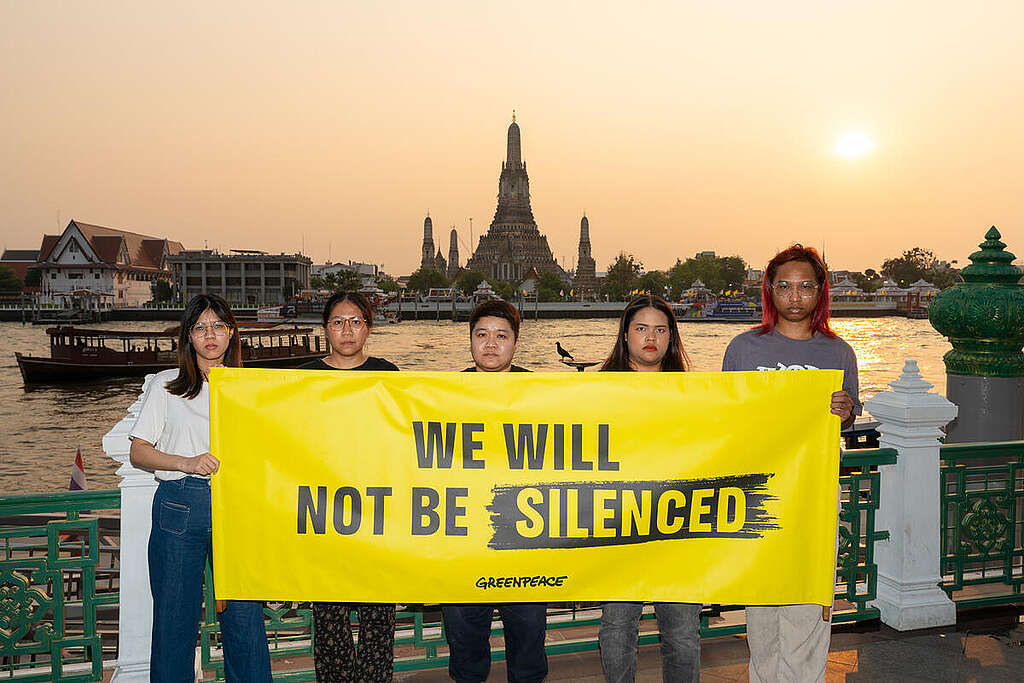
 Thailand: Activists from Greenpeace Thailand gathered at an iconic place in Bangkok, Thailand, to show solidarity with the global movement for climate justice. Holding banners reading “We will not be silenced” and “Stop Big Oil Bullies”, the group called for an end to the intimidation tactics used by fossil fuel companies like Energy Transfer, attempting to intimidate climate activists, journalists, and anyone who dares speak truth to power.
Thailand: Activists from Greenpeace Thailand gathered at an iconic place in Bangkok, Thailand, to show solidarity with the global movement for climate justice. Holding banners reading “We will not be silenced” and “Stop Big Oil Bullies”, the group called for an end to the intimidation tactics used by fossil fuel companies like Energy Transfer, attempting to intimidate climate activists, journalists, and anyone who dares speak truth to power.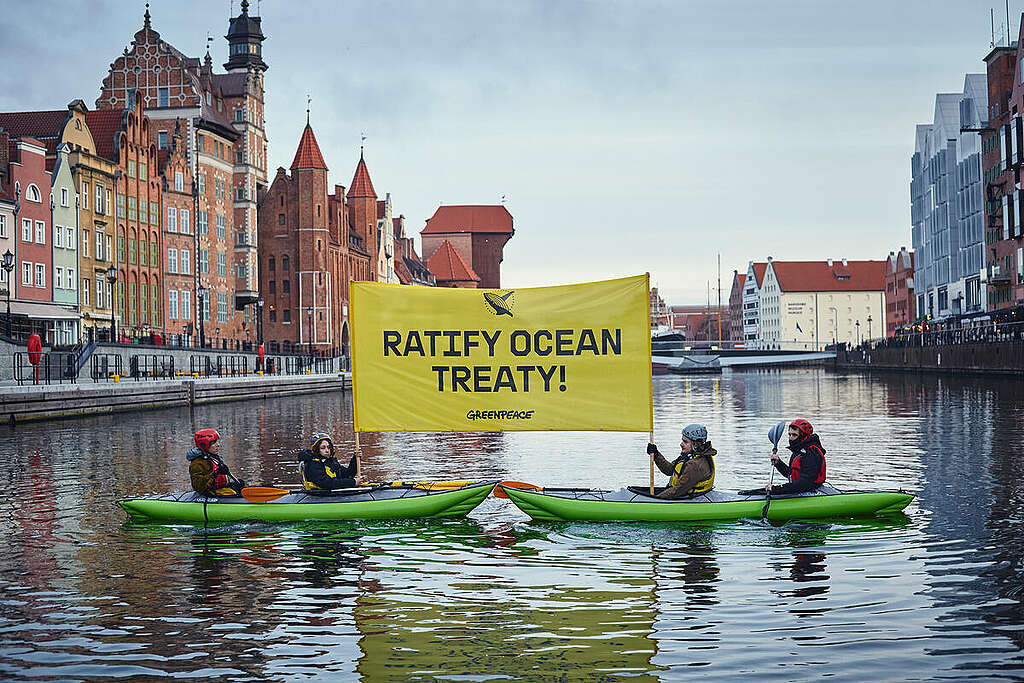
 Poland: Greenpeace Poland activists on kayaks in Gdansk demanded an urgent ratification of the Ocean Treaty. For more than two decades, Greenpeace and other civil society organizations have been seeking a Global Oceans Treaty to protect marine ecosystems from harmful industries, the Global Ocean Treaty. More than 60 countries have now ratified the agreement. This is a massive achievement for all the activists, supporters and allies who stood up and raised their voices for ocean protection in recent years.
Poland: Greenpeace Poland activists on kayaks in Gdansk demanded an urgent ratification of the Ocean Treaty. For more than two decades, Greenpeace and other civil society organizations have been seeking a Global Oceans Treaty to protect marine ecosystems from harmful industries, the Global Ocean Treaty. More than 60 countries have now ratified the agreement. This is a massive achievement for all the activists, supporters and allies who stood up and raised their voices for ocean protection in recent years. 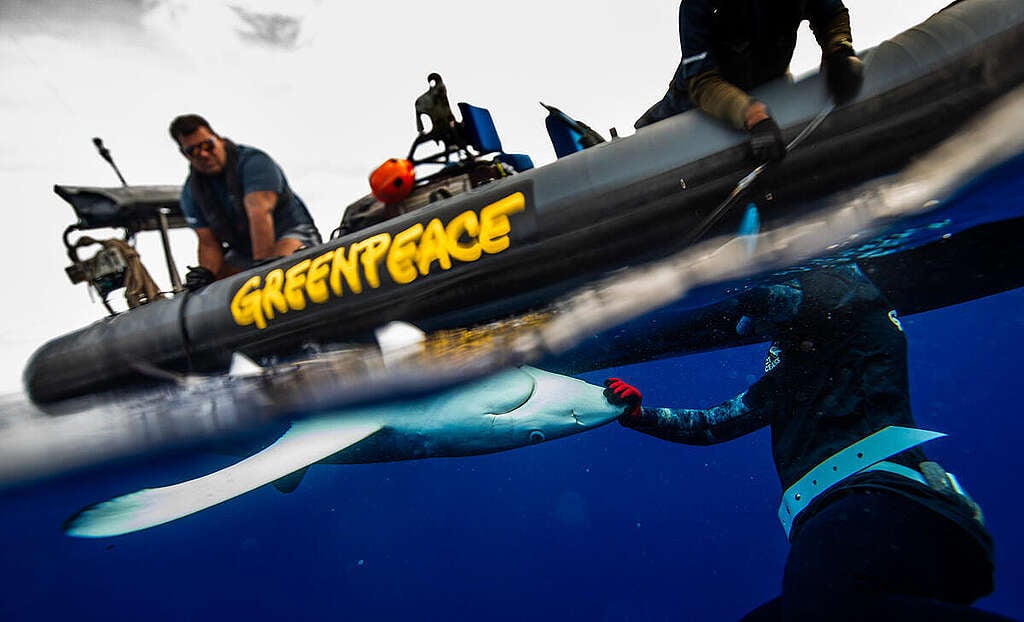
 Australia: A shark handler and Greenpeace RHIB team free a blue shark caught on a longline in the Pacific Ocean. The blue shark is currently listed as “Near Threatened” globally by the International Union for Conservation of Nature (IUCN). Greenpeace Australia Pacific took action to stop an industrial longlining fishing operation in the South Pacific Ocean, seizing more than 20 kilometres of fishing gear and freeing nine sharks, including an endangered mako, near Australia and New Zealand.
Australia: A shark handler and Greenpeace RHIB team free a blue shark caught on a longline in the Pacific Ocean. The blue shark is currently listed as “Near Threatened” globally by the International Union for Conservation of Nature (IUCN). Greenpeace Australia Pacific took action to stop an industrial longlining fishing operation in the South Pacific Ocean, seizing more than 20 kilometres of fishing gear and freeing nine sharks, including an endangered mako, near Australia and New Zealand.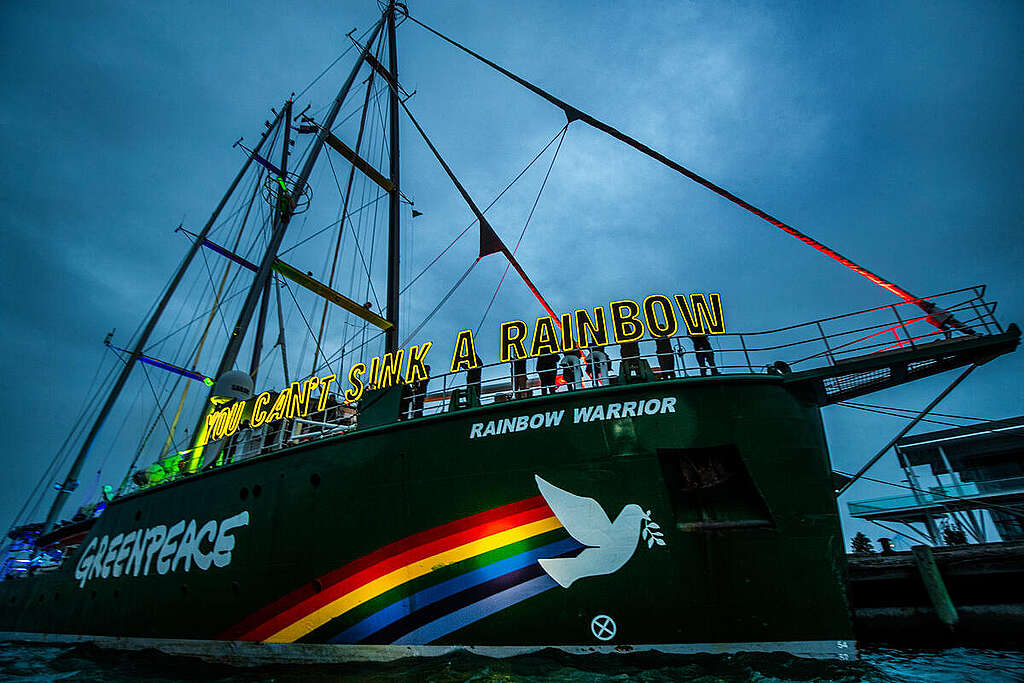
 New Zealand: The Rainbow Warrior is lit up as a “beacon of resistance” in Auckland today on the eve of the 40th anniversary of the bombing of the original Rainbow Warrior by French Government agents in 1985. Twenty crew and Greenpeace Aotearoa staff and volunteers hold letters of light spelling out the iconic phrase, You Can’t Sink A Rainbow.
New Zealand: The Rainbow Warrior is lit up as a “beacon of resistance” in Auckland today on the eve of the 40th anniversary of the bombing of the original Rainbow Warrior by French Government agents in 1985. Twenty crew and Greenpeace Aotearoa staff and volunteers hold letters of light spelling out the iconic phrase, You Can’t Sink A Rainbow.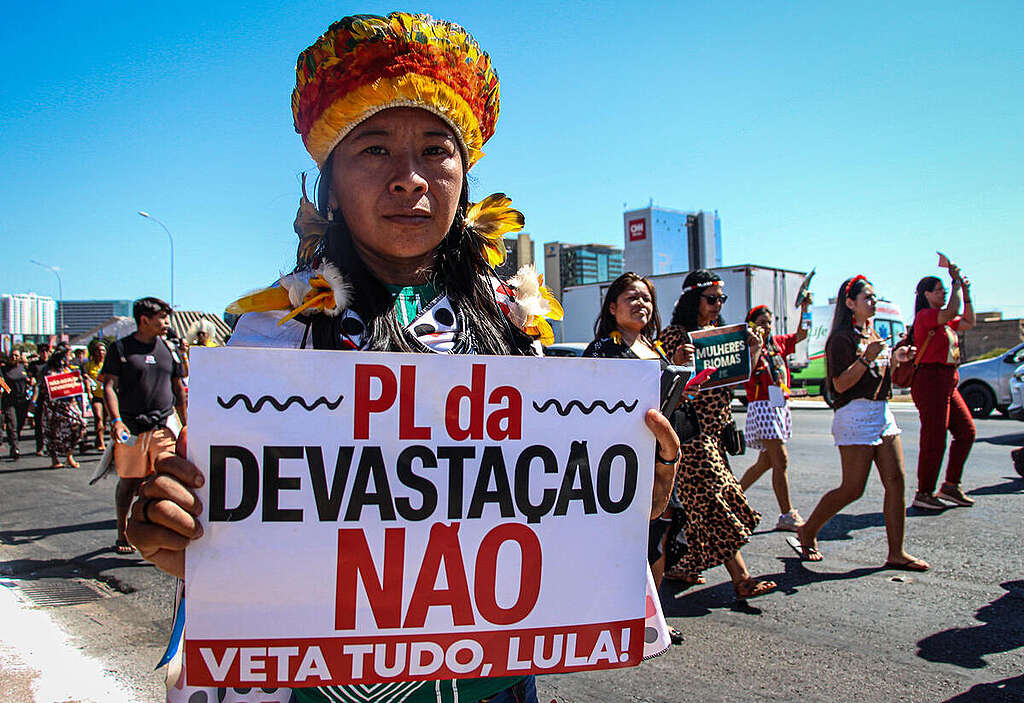
 Brazil: Between August 5 and 7, the Greenpeace Brazil Volunteer Team was in Brasília to participate in the 4th Indigenous Women’s March, which this year carried the theme: “Our Body, Our Territory: We Are Guardians of the Planet for the Healing of the Earth.” During the march, we joined forces with Indigenous women from across Brazil, carrying our banner reading “VET IT, LULA” in protest against the so-called “PL da Devastação”, which threatens to weaken environmental licensing and put forests, rivers, and traditional ways of life at risk. We also distributed themed hand fans, which featured information about the Indigenous Women’s House — a crucial initiative that provides shelter and specialized care. This meeting marked a significant step toward advancing public policies that ensure the protection and dignity of Indigenous women.
Brazil: Between August 5 and 7, the Greenpeace Brazil Volunteer Team was in Brasília to participate in the 4th Indigenous Women’s March, which this year carried the theme: “Our Body, Our Territory: We Are Guardians of the Planet for the Healing of the Earth.” During the march, we joined forces with Indigenous women from across Brazil, carrying our banner reading “VET IT, LULA” in protest against the so-called “PL da Devastação”, which threatens to weaken environmental licensing and put forests, rivers, and traditional ways of life at risk. We also distributed themed hand fans, which featured information about the Indigenous Women’s House — a crucial initiative that provides shelter and specialized care. This meeting marked a significant step toward advancing public policies that ensure the protection and dignity of Indigenous women.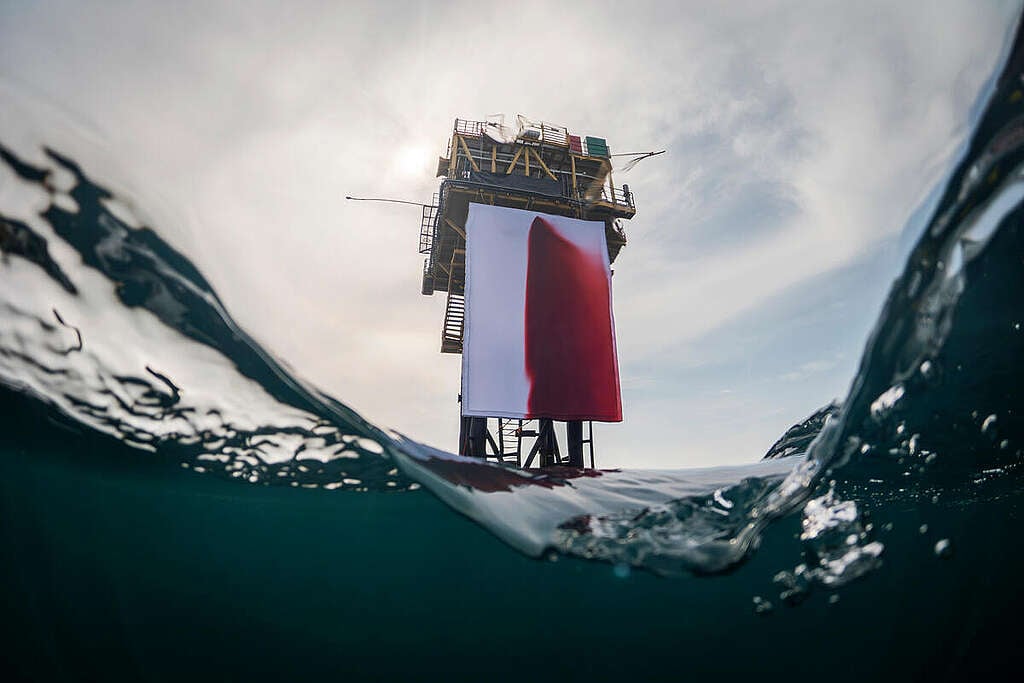
 United Kingdom: Greenpeace UK climbers install a major new work by renowned artist Anish Kapoor titled BUTCHERED onto a Shell platform in the North Sea – the world’s first artwork to be installed at an active offshore gas site. After securing a giant 12m x 8m canvas to one side of the structure, the activists hoisted a high-pressure hose onto the canvas at a height of 16 metres above the sea. They then pumped 1,000 litres of blood-red liquid that gushed into the fabric, creating a vast crimson stain. The work is a stark visualisation of the wound inflicted on both humanity and the Earth by the fossil fuel industry, evocative of our collective grief and pain at what has been lost, but also a cry for reparation.
United Kingdom: Greenpeace UK climbers install a major new work by renowned artist Anish Kapoor titled BUTCHERED onto a Shell platform in the North Sea – the world’s first artwork to be installed at an active offshore gas site. After securing a giant 12m x 8m canvas to one side of the structure, the activists hoisted a high-pressure hose onto the canvas at a height of 16 metres above the sea. They then pumped 1,000 litres of blood-red liquid that gushed into the fabric, creating a vast crimson stain. The work is a stark visualisation of the wound inflicted on both humanity and the Earth by the fossil fuel industry, evocative of our collective grief and pain at what has been lost, but also a cry for reparation.
 The Philippines: Impacts of the combined effects of Severe Tropical Storm “Crising” (International name: Wipha) and the southwest monsoon’s torrential rains are being felt across the Philippines—flooding communities like those in Calumpit, Bulacan, and disrupting lives, livelihoods, and even important moments like weddings. Southeast Asia’s extended monsoon season brought in relentless rains in Nepal, Thailand, Vietnam, and Indonesia, causing some of the worst flooding in recent history. Over a hundred people have died in the region, and thousands have been forced to leave their homes.
The Philippines: Impacts of the combined effects of Severe Tropical Storm “Crising” (International name: Wipha) and the southwest monsoon’s torrential rains are being felt across the Philippines—flooding communities like those in Calumpit, Bulacan, and disrupting lives, livelihoods, and even important moments like weddings. Southeast Asia’s extended monsoon season brought in relentless rains in Nepal, Thailand, Vietnam, and Indonesia, causing some of the worst flooding in recent history. Over a hundred people have died in the region, and thousands have been forced to leave their homes.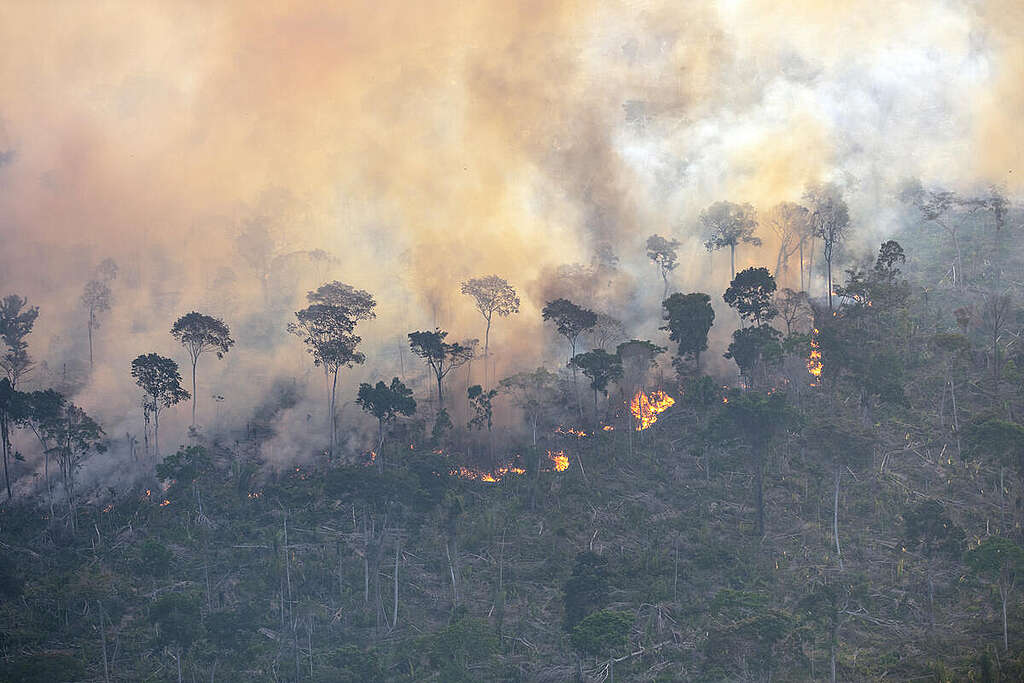
 Brazil: Greenpeace Brazil conducted an aerial survey in the Amazon region to monitor deforestation and forest fires. The flight documented cattle ranches, deforested areas, and environmental destruction. Influencers were invited to participate in the survey, helping to amplify the urgency of protecting the forest by sharing their experiences and reactions.
Brazil: Greenpeace Brazil conducted an aerial survey in the Amazon region to monitor deforestation and forest fires. The flight documented cattle ranches, deforested areas, and environmental destruction. Influencers were invited to participate in the survey, helping to amplify the urgency of protecting the forest by sharing their experiences and reactions.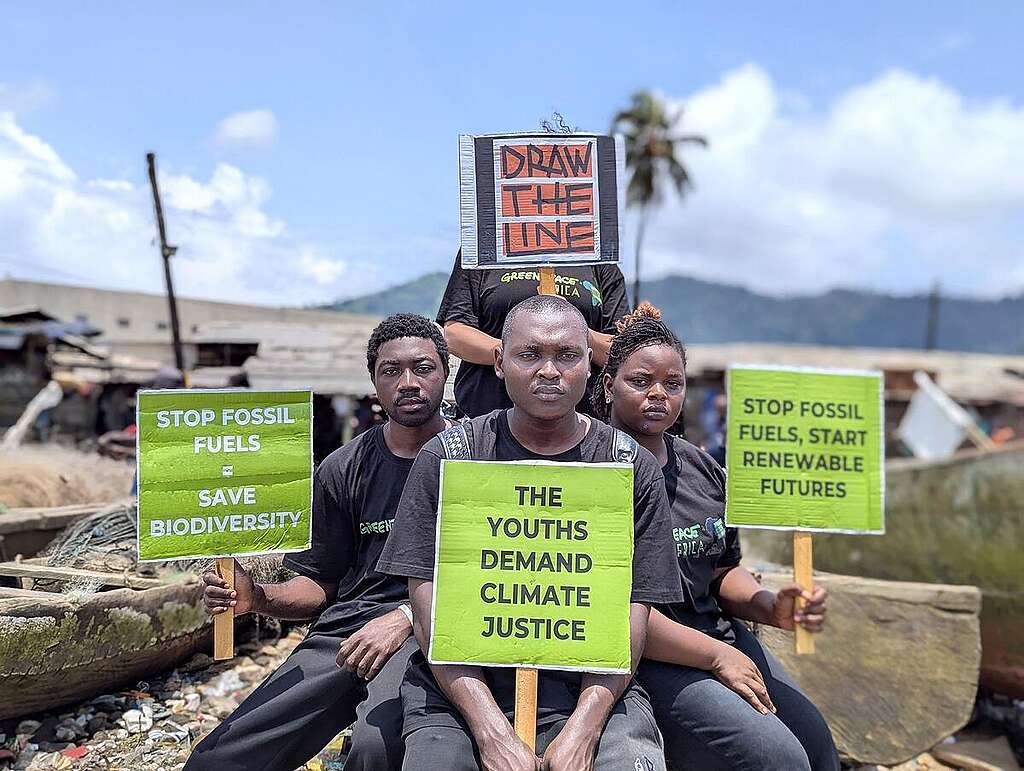
 Cameroon: In Cameroon, Greenpeace Africa volunteers Yaoundé and Buea will contribute through photo-ops, using visual storytelling to highlight environmental injustices and amplify the voices of youth demanding change.
Cameroon: In Cameroon, Greenpeace Africa volunteers Yaoundé and Buea will contribute through photo-ops, using visual storytelling to highlight environmental injustices and amplify the voices of youth demanding change.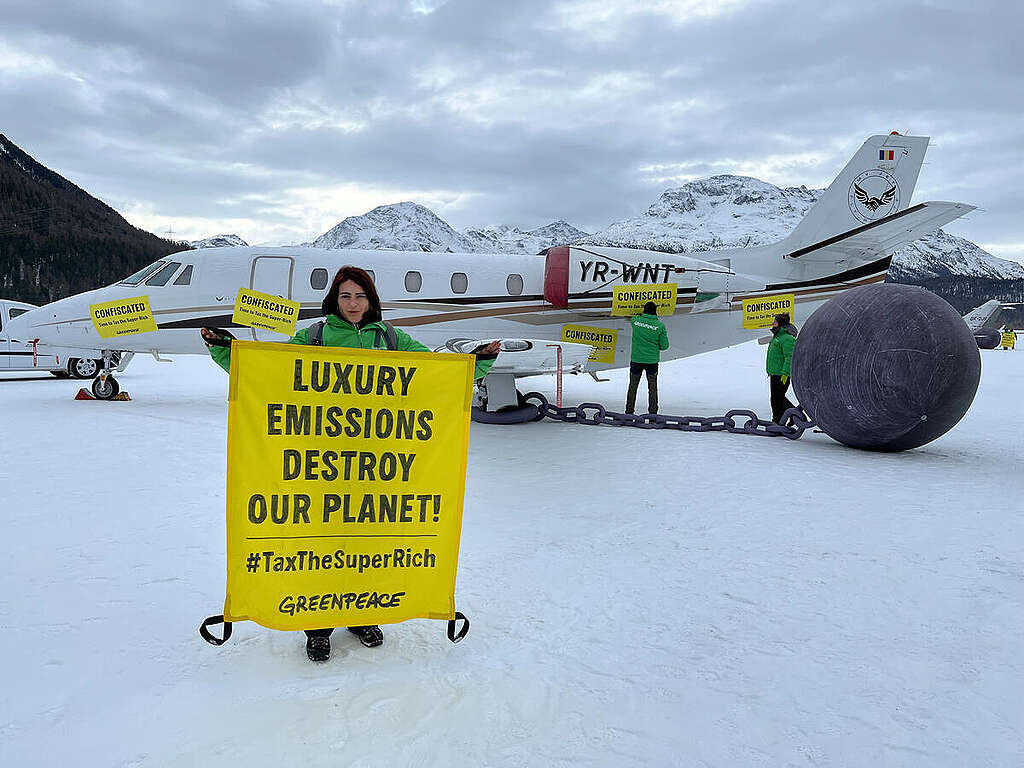
 Switzerland: The peaceful protest marks the last in a series of creative interventions calling on policymakers to tax the super-rich, who represent 1% of the world’s population, and redirect tax revenues towards affordable green housing, public transportation, and climate and environmental action, to support communities and protect the planet.
Switzerland: The peaceful protest marks the last in a series of creative interventions calling on policymakers to tax the super-rich, who represent 1% of the world’s population, and redirect tax revenues towards affordable green housing, public transportation, and climate and environmental action, to support communities and protect the planet.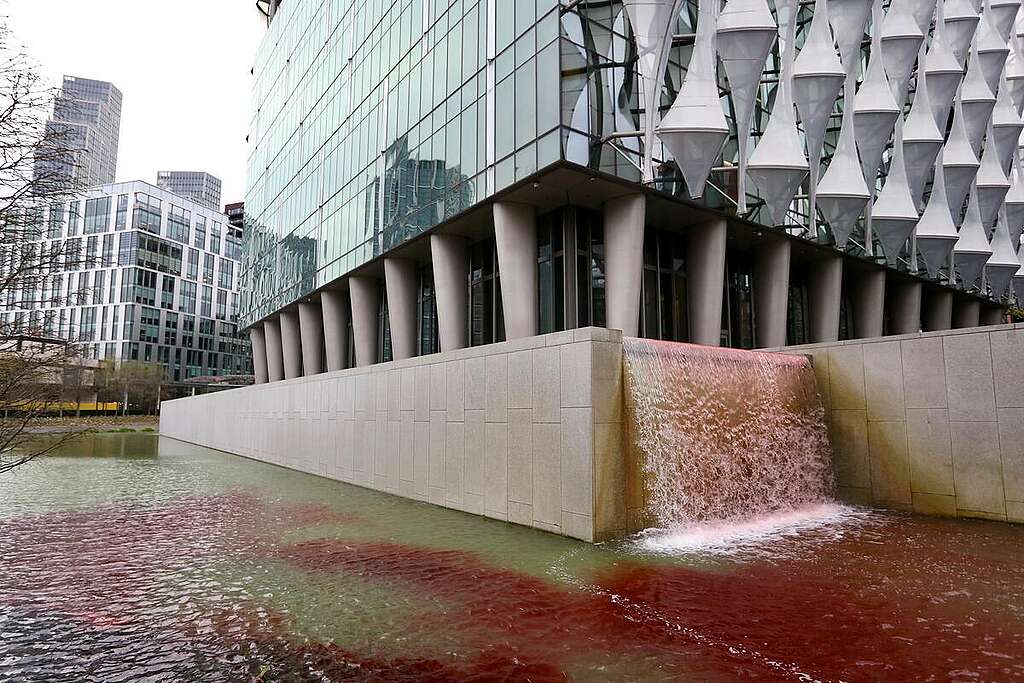
 United Kingdom: Greenpeace UK activists pour 300 litres of blood-red dye into the US Embassy pond in London, to highlight the death and devastation caused in Gaza as a direct result of the US’ continued sale of weapons, ammunition and military hardware to Israel. Twelve activists tipped the non-toxic, biodegradable dye from containers emblazoned with the words ‘Stop Arming Israel’ into the large pond located in front of the embassy building in Nine Elms, south-west London.
United Kingdom: Greenpeace UK activists pour 300 litres of blood-red dye into the US Embassy pond in London, to highlight the death and devastation caused in Gaza as a direct result of the US’ continued sale of weapons, ammunition and military hardware to Israel. Twelve activists tipped the non-toxic, biodegradable dye from containers emblazoned with the words ‘Stop Arming Israel’ into the large pond located in front of the embassy building in Nine Elms, south-west London.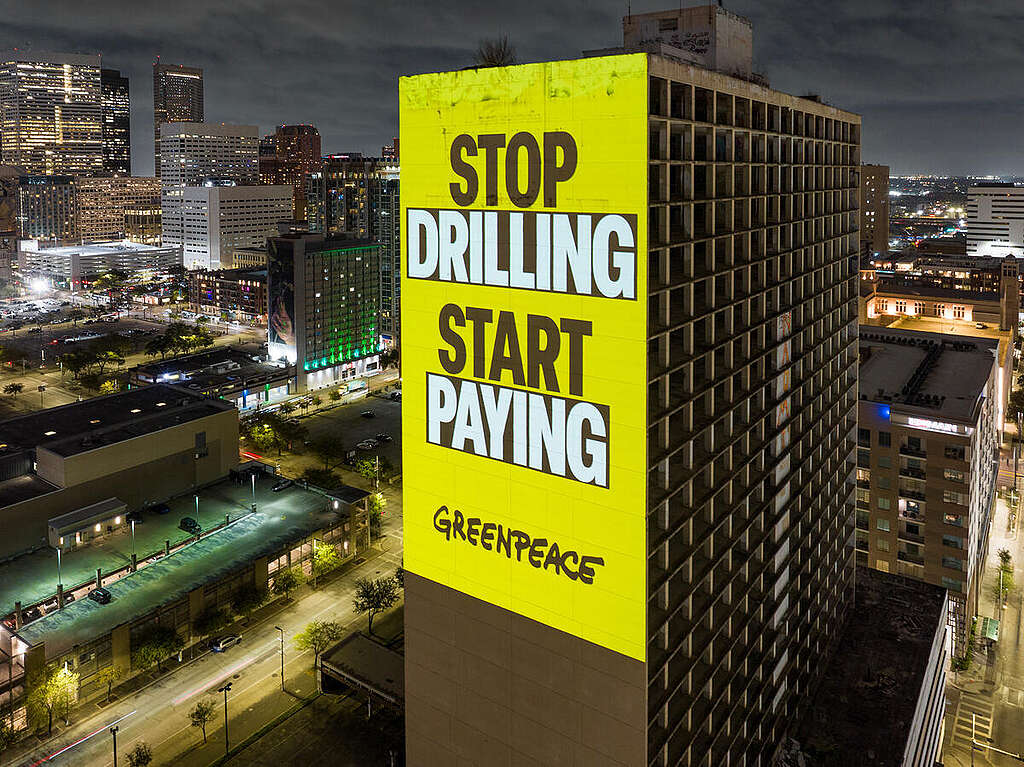
 United States of America (USA): A bold “Make Polluters Pay” projection lit up Houston during CERAWeek—the fossil fuel industry’s so-called “Super Bowl”—calling out Big Oil for its central role in driving the climate crisis. The campaign demands that the industry not only be held accountable for past damage, but also be forced to fund the costs of preparing our communities for the escalating impacts of climate change.
United States of America (USA): A bold “Make Polluters Pay” projection lit up Houston during CERAWeek—the fossil fuel industry’s so-called “Super Bowl”—calling out Big Oil for its central role in driving the climate crisis. The campaign demands that the industry not only be held accountable for past damage, but also be forced to fund the costs of preparing our communities for the escalating impacts of climate change.Honorable mentions
Bon Pote
Actu-Environnement
Amis de la Terre
Aspas
Biodiversité-sous-nos-pieds
Bloom
Canopée
Décroissance (la)
Deep Green Resistance
Déroute des routes
Faîte et Racines
Fracas
F.N.E (AURA)
Greenpeace Fr
JNE
La Relève et la Peste
La Terre
Le Lierre
Le Sauvage
Low-Tech Mag.
Motus & Langue pendue
Mountain Wilderness
Negawatt
Observatoire de l'Anthropocène

 (@greenpeace)
(@greenpeace)